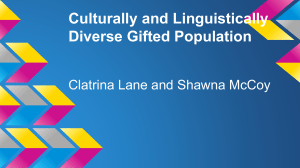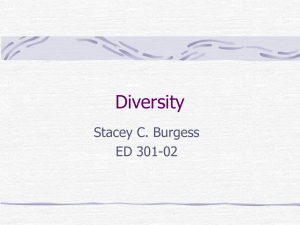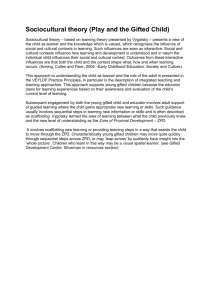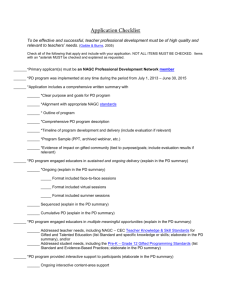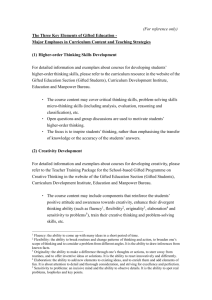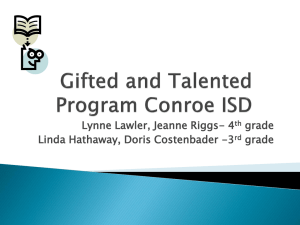Minority Students In Special and Gifted Education as it
advertisement
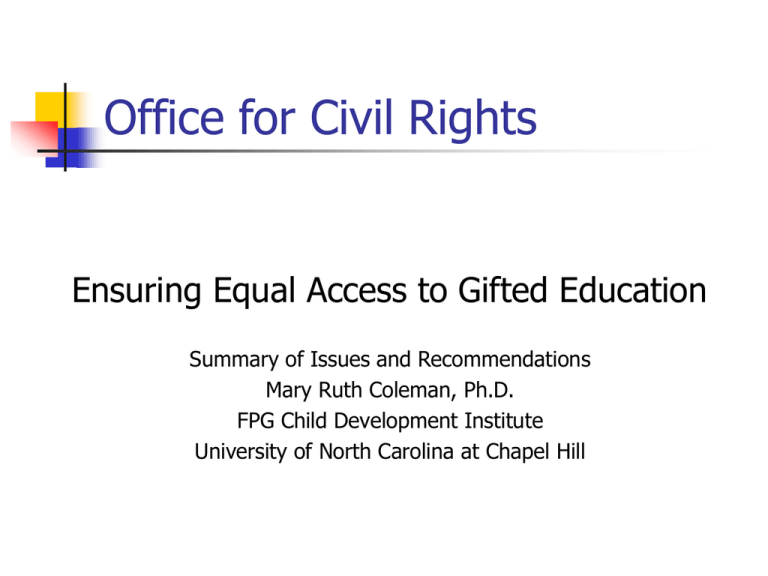
Office for Civil Rights Ensuring Equal Access to Gifted Education Summary of Issues and Recommendations Mary Ruth Coleman, Ph.D. FPG Child Development Institute University of North Carolina at Chapel Hill Disproportionate under-representation persists in programs for gifted children, despite the growing proportion of students from culturally/linguistically diverse families in the population of school-aged children National Research Council (2002) Increasing understanding that characteristics of a child can not be judged with the “fixed-trait” model that has historically been used. The context of the child must me considered. National Research Council (2002) Major Issues-Gifted Education Identification of Students Placement Decisions Program Participation Program Implementation Appropriate Identification Notice to Parents and Care Givers Screening/Student Search Planned Experiences for Students Multiple Criteria (not Multiple Hoops to Jump) multiple sources multiple time periods multiple types (including alternative assessments) Placement Decisions Appropriate service option match based on needs Multiple criteria inform decision (a single piece of evidence can be used to match a child to appropriate services but NO SINGLE piece of evidence can be used to deny appropriate services) Personnel Preparation for decision makers Program Participation Appropriate procedures: continuation of services exit criteria Equity in access across service/grade levels Support mechanisms to reduce selfselection out Program Implementation Quality of services is equitable—not dependent on “address” Personnel Preparation for all with a role in the process Data-Informed Decision-Making Data-Informed Decision-Making Determine baseline data District overall and by school Service delivery option, grade level Program referrals, participation, and withdrawals by race, ethnicity, language status, gender, and disability Compare with District and school enrollment by race, ethnicity, language status, gender, and disability Fair Rules and Regulations are a point of departure not a destination Building school level capacity (to observe, understand, and respond to student differences) is essential Progress must be documented and monitored National Research Council (2002) Remember That: A child’s achievement and behavior is determined by the interaction of the child, the teacher, and the classroom environment It also goes beyond the classroom: schools, school systems, families, and communities all play a role in shaping a child. National Research Council (2002) Question Does schooling independently contribute to the incidence of giftedness among students in different racial/ethnic groups through the opportunities that it provides? National Research Council (2002) Answer Yes – Schools with higher concentrations of low-income and culturally/linguistically diverse students have fewer well-trained teachers, lower per pupil expenditures, and fewer opportunities for advanced and enriched coursework. National Research Council (2002) Advocacy Starts with Each of Us Recognize the Problem Have the Courage to Speak-out Build Your Coalition of Support Establish Your Baseline Data Don’t Give Up Until You Have Made the Difference You Want to See! Looking at your progress Self-assessment Review all policies that impact Plan your approach Plan for improvement Implement changes Ongoing review Recommendations for Gifted Education (1) (2) (3) Research on early identification and intervention with children who exhibit advanced performance in the verbal or quantitative realm or who exhibit other advanced abilities. Teacher quality and certification/licensure Rigorous professional development National Research Council (2002) To make the changes it will take: (1) (2) (3) Investment in building the capacity of teachers and other educational professionals Changing incentives and standard practices in the assessment processes so that children are identified early, when they can be helped most effectively Compliance monitoring that focuses on treatments in both general and special education (p. 10-4) National Research Council (2002)





